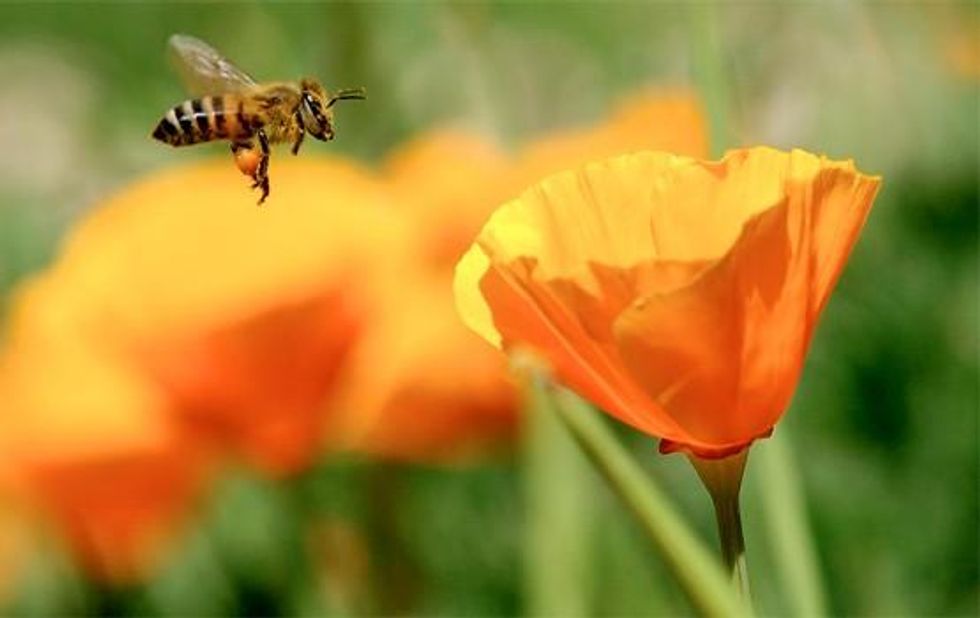

SUBSCRIBE TO OUR FREE NEWSLETTER
Daily news & progressive opinion—funded by the people, not the corporations—delivered straight to your inbox.
5
#000000
#FFFFFF
To donate by check, phone, or other method, see our More Ways to Give page.


Daily news & progressive opinion—funded by the people, not the corporations—delivered straight to your inbox.

"America's beekeepers cannot survive for long with the toxic environment EPA has supported."
In the United States, the Department of Agriculture and the Environmental Protection Agency released a report in May on honeybee health, the result of collaboration among officials, researchers, beekeepers, and food producers. According to entomologist and beekeeper Dennis vanEngelsdorp, the report is more comprehensive than previous versions and recommends a shift from reactive to proactive policy.
Ongoing scientific research identifies various causes behind the decline of bees, so the problem will require a variety of solutions, says vanEngelsdorp. Knowing the effects of chemicals on bees is complicated, he says, because multiple chemicals interact in the hive and "one plus one doesn't always equal two."
VanEngelsdorp says individuals can do a lot to help. Growing flowering plants instead of grass is one easy step. Limiting pesticide use is another. "The people who use the most pesticides per acre are people who live in the city and backyard gardeners," said vanEngelsdorp. The province of Ontario has recently banned some pesticides. Oregon temporarily banned dinotefuran, a neonic, after 50,000 bumblebees died when ornamental trees were sprayed with the chemical. And corporate accountability group SumofUs is raising funds to send beekeepers to a conference for garden-store owners. They'll ask the store owners not to stock pesticides that kill bees.
Other bee protectors are using the legal system. Four beekeepers, along with the Center for Food Safety, Beyond Pesticides, Pesticide Action Network, the Sierra Club, and the Center for Environmental Health, filed a lawsuit on March 21.
They're charging the EPA with failing to protect honeybees from clothianidin and thiamethoxam, two of the neonics included in the EU ban. "America's beekeepers cannot survive for long with the toxic environment EPA has supported," said Steve Ellis, one of the beekeepers bringing the lawsuit. "It's time for the EPA to recognize the value of bees to our food system and agricultural economy."
This article was written for YES! Magazine, a national, nonprofit media project that fuses powerful ideas with practical actions.
Dear Common Dreams reader, The U.S. is on a fast track to authoritarianism like nothing I've ever seen. Meanwhile, corporate news outlets are utterly capitulating to Trump, twisting their coverage to avoid drawing his ire while lining up to stuff cash in his pockets. That's why I believe that Common Dreams is doing the best and most consequential reporting that we've ever done. Our small but mighty team is a progressive reporting powerhouse, covering the news every day that the corporate media never will. Our mission has always been simple: To inform. To inspire. And to ignite change for the common good. Now here's the key piece that I want all our readers to understand: None of this would be possible without your financial support. That's not just some fundraising cliche. It's the absolute and literal truth. We don't accept corporate advertising and never will. We don't have a paywall because we don't think people should be blocked from critical news based on their ability to pay. Everything we do is funded by the donations of readers like you. Will you donate now to help power the nonprofit, independent reporting of Common Dreams? Thank you for being a vital member of our community. Together, we can keep independent journalism alive when it’s needed most. - Craig Brown, Co-founder |

"America's beekeepers cannot survive for long with the toxic environment EPA has supported."
In the United States, the Department of Agriculture and the Environmental Protection Agency released a report in May on honeybee health, the result of collaboration among officials, researchers, beekeepers, and food producers. According to entomologist and beekeeper Dennis vanEngelsdorp, the report is more comprehensive than previous versions and recommends a shift from reactive to proactive policy.
Ongoing scientific research identifies various causes behind the decline of bees, so the problem will require a variety of solutions, says vanEngelsdorp. Knowing the effects of chemicals on bees is complicated, he says, because multiple chemicals interact in the hive and "one plus one doesn't always equal two."
VanEngelsdorp says individuals can do a lot to help. Growing flowering plants instead of grass is one easy step. Limiting pesticide use is another. "The people who use the most pesticides per acre are people who live in the city and backyard gardeners," said vanEngelsdorp. The province of Ontario has recently banned some pesticides. Oregon temporarily banned dinotefuran, a neonic, after 50,000 bumblebees died when ornamental trees were sprayed with the chemical. And corporate accountability group SumofUs is raising funds to send beekeepers to a conference for garden-store owners. They'll ask the store owners not to stock pesticides that kill bees.
Other bee protectors are using the legal system. Four beekeepers, along with the Center for Food Safety, Beyond Pesticides, Pesticide Action Network, the Sierra Club, and the Center for Environmental Health, filed a lawsuit on March 21.
They're charging the EPA with failing to protect honeybees from clothianidin and thiamethoxam, two of the neonics included in the EU ban. "America's beekeepers cannot survive for long with the toxic environment EPA has supported," said Steve Ellis, one of the beekeepers bringing the lawsuit. "It's time for the EPA to recognize the value of bees to our food system and agricultural economy."
This article was written for YES! Magazine, a national, nonprofit media project that fuses powerful ideas with practical actions.

"America's beekeepers cannot survive for long with the toxic environment EPA has supported."
In the United States, the Department of Agriculture and the Environmental Protection Agency released a report in May on honeybee health, the result of collaboration among officials, researchers, beekeepers, and food producers. According to entomologist and beekeeper Dennis vanEngelsdorp, the report is more comprehensive than previous versions and recommends a shift from reactive to proactive policy.
Ongoing scientific research identifies various causes behind the decline of bees, so the problem will require a variety of solutions, says vanEngelsdorp. Knowing the effects of chemicals on bees is complicated, he says, because multiple chemicals interact in the hive and "one plus one doesn't always equal two."
VanEngelsdorp says individuals can do a lot to help. Growing flowering plants instead of grass is one easy step. Limiting pesticide use is another. "The people who use the most pesticides per acre are people who live in the city and backyard gardeners," said vanEngelsdorp. The province of Ontario has recently banned some pesticides. Oregon temporarily banned dinotefuran, a neonic, after 50,000 bumblebees died when ornamental trees were sprayed with the chemical. And corporate accountability group SumofUs is raising funds to send beekeepers to a conference for garden-store owners. They'll ask the store owners not to stock pesticides that kill bees.
Other bee protectors are using the legal system. Four beekeepers, along with the Center for Food Safety, Beyond Pesticides, Pesticide Action Network, the Sierra Club, and the Center for Environmental Health, filed a lawsuit on March 21.
They're charging the EPA with failing to protect honeybees from clothianidin and thiamethoxam, two of the neonics included in the EU ban. "America's beekeepers cannot survive for long with the toxic environment EPA has supported," said Steve Ellis, one of the beekeepers bringing the lawsuit. "It's time for the EPA to recognize the value of bees to our food system and agricultural economy."
This article was written for YES! Magazine, a national, nonprofit media project that fuses powerful ideas with practical actions.